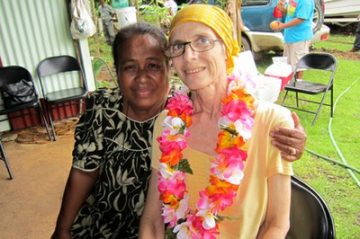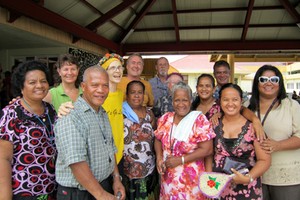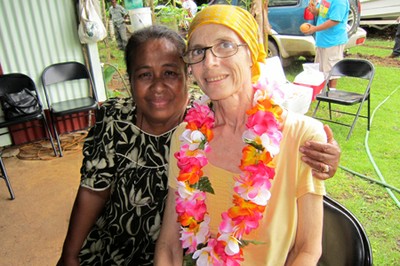Located in the western Pacific ocean, Pohnpei Island is the largest island of the state of Pohnpei, one of the four states that make up the Federated States of Micronesia (FSM). Although rich in biodiversity, in recent years there has been a steady decline in the use of traditional agriculture and local foods, and a subsequent rise in nutrition-related disorders, such as vitamin A deficiency, diabetes, heart disease and cancer. Thanks to “Let’s Go Local”, a campaign launched in 2004 by the Island Food Community of Pohnpei, communities are gradually adopting healthier diets based on the richness of local foods. Lois Englberger, Acting Director and Research Advisor, and one of the founders of the organisation, explained to us what makes a community project successful.

“The slogan was famous and was already rolling off everyone’s tongues, so we decided for ‘Let’s Go Local’, meaning ‘involve us’”. “Our project is not about helping people do something, but about doing it together. The approach we adopted is not top down, but very much a grassroots effort”.
What has changed in Pohnpei over the past 50 years?
Like everywhere else in the world, traditional food systems in Pohnpei are changing. Modern lifestyles are bringing new ways of eating, of growing and producing food that’s cheaper and easier to prepare. Lifestyles have changed. People are now employed and no longer work on their traditional food systems like they used to. Imported foods are much easier to come by. If you’re working you go to a shop and it’s much easier to buy a bag of rice than it is to dig a hole to get out a taro or climb a tree to get breadfruit. Things have also changed due to feelings about what is valuable and what is not. As well as being cheaper and more convenient, imported foods have a higher status with the community. To make matters worse, the market system for local foods is poorly developed; commercially, local foods have been neglected. Furthermore, the general perception is that farming is an unprofitable and outdated way of making a living and is generally looked down upon by the younger generations, whose views are fully justified since commercial agriculture has not yet developed in Micronesia.
What are the health problems associated with this change?
Studies carried out after World War II in Pohnpei showed no evidence of malnutrition among the population and an almost complete absence of obesity. In 50 years health in the FSM has gone severely downhill. Nowadays, stunting, vitamin A deficiency and dental decay among children is abundant, not to mention that one in three Pohnpeians are affected by diabetes, and overweight is so common that it’s seen as the norm.
These changes in health are directly linked to changes in lifestyle and diets, in which traditional foods such as fish, root crops and starchy fruits (breadfruits and banana), vegetables and fruits have been substituted by imported foods such as white rice, flour products, sugar, fatty meats, soft drinks and other sweet processed foods.
So why start the Let’s Go Local campaign?

That said, we are not proposing to completely drop all imported products – nothing wrong with some modern food. But the aim is to help communities rediscover the nutritional and health benefits that local foods can offer. Furthermore, many of these foods are associated with local traditions.
For instance at the beginning of the yam season, it was a custom to present the village chief with a basket of yams before all the village could start partaking in the harvest. These traditions are gradually breaking down, with yams being substituted by rice or money. By encouraging people to eat and produce local foods, we also hope to preserve the culture and knowledge associated with it.
How easy is it to get the message across?
A few people understand, but spreading the word further is a challenge. It takes time and a lot of patience. There is still a strong stigma attached to health problems, diabetes especially, and many people deny being affected by it. The idea is to start small and win over smaller communities first and then to reach out to wider audiences. In 2005 the Island Food Community of Pohnpei joined efforts with a global health project led by the Centre for Indigenous Peoples’ Nutrition and Environment (CINE), to document the diversity of local foods and gather information about health and diets. Target villages were selected based on their willingness to participate in the project, and on the availability of local foods. When survey results were published the communities were surprised to find out the high incidence of diabetes. It emerged as a collective problem and people really started to realise they are neglecting their health.
hat were the most successful means to raise awareness for the Project?
Local leaders, such as Adelino Lorens, Chairman of Island Food Community and Chief of Agriculture, played an essential role in raising awareness about the importance of local food systems. With their help, the project adopted a communitybased approach targeting both older and younger generations. Community leaders would stand up during gatherings and explain the serious health risks people faced and how they could improve their health by changing their diets.
All the regular raising awareness methods were used: Tshirts and caps, which are really popular; but what really worked beyond our expectation was our Let’s Go Local song, which is sung to start or end meetings, and has been used as the theme song for the video “Going Yellow” and as the jingle for our regular radio releases. High school students have become involved in the campaign and formed the “Let’s Go Local High School Club”, giving talks on the value of local foods and singing the song in school plays. Food posters showing the different varieties of carotenoidrich food have also become a symbol of our campaign and are exhibited at every workshop to help reintroduce varieties of taro, pandanus and breadfruit that are now less known or neglected.
Another activity that has proved highly successful is foodgrowing competitions, because large yams and breadfruits are culturally highly prized within Pohnpei. Experience has also shown that the message can have a larger impact when organised within the framework of larger events such as World Food Day, held every year on the 16th of October.
What didn’t work?
Because the FSM is traditionally an oral society we found that written documents, like newsletters, worked for some groups – leaders especially – but not for the community. Furthermore, we found that people were reticent when simply advised to plant more local foods. Cooking classes and recipes thus proved to be a very effective means of motivating people, and inspiring them to want to grow local food. In general, however, perceptions are very difficult to change. Although community members were told on a number of occasions that their unhealthy lifestyles were to blame for their failing health it seemed like the message didn’t really sink in. People close their ears to messages, so we learnt that repetition is important.
Is there any marketing that tries to promote traditional food?
People do it, but only on an informal basis. For instance, although the karat banana was known for its highly nutritious properties and traditionally given to babies once they stopped breastfeeding, it wasn’t being sold in markets, but was only being grown in homegardens. In 1998, as a result of scientific findings confirming the nutritional properties of the orange karat, the Head of the Health Service, Dr Pretrick, started promoting the fruit that can now be widely found in markets throughout Pohnpei. Coconut products are also being developed but are still marketed only on a smallscale because of the lack of an adequate transport system.
Farmers wanting to sell their extra crops are reluctant to trek long distances to the nearest market, without the certainty of being able to sell their produce. Misperceptions (often coming from abroad) about certain foods have further hindered the commercialisation of local crops such as taro, which is usually considered to be just starch. Yet food analysis for this root crop show that some varieties are rich in betacarotene, high in essential nutrients like iron, calcium and zinc and packed with vitamins and fibre that can help protect against diabetes.
The lack of a real food industry in the country hasn’t helped, and limited efforts have been made to market local products, which are perceived as being “old” by the younger generations who are more attracted to the flashy packaging of imported foods. So, we can safely say that the marketing of raw crops hasn’t worked.
On the other hand, what has worked is the marketing of small, cooked takeouts made with local foods that are sold on roadside stands as lunchtime snacks. Sales of coconut taro balls for instance, which are hard to make at home, have boomed thanks to the “Let’s Go Local” campaign.
Were you able to influence policy-makers to promote local foods?
The project has been successful at many levels in winning over the support of decisionmakers. Luckily for our campaign, Pohnpei is a very small island and we know all the policy makers on a personal basis, including the President of FSM, Emanuel “Manny” Mori, who is very active and close to the project. Invited as a keynote speaker at the World Food Day (October 16th), the President ended his speech with the “Let’s Go Local” slogan, as well as symbolically planting banana and breadfruit trees during official visits to promote our cause. Also noteworthy is a Presidential Proclamation of 2010 encouraging the use of local food at all FSM government events.
Collaboration with the FSM’s Department of Health and Social Affairs and Pohnpei’s State Department of Health has led to the drafting of a bill to increase taxes on food imports, particularly soft drinks, which are responsible for many of the health problems in FSM. The bill is currently being considered for adoption. In 2005 the karat was proclaimed as the Pohnpei State Banana, based on its traditional value and exceptionally rich nutrient content, giving prestige to this neglected species. The Project also worked with the philatelic bureau to produce a karat stamp series, a Micronesian banana series and a coconut commemorative stamp series, which in turn led to proclamation of National Coconut Day.
Furthermore, the Governor of Pohnpei is keen on launching a school lunch programme that incorporates traditional food items in school menus.
Has there been a follow-up investigation on the health status?
There hasn’t been a followup survey since the health assessment that was carried out two years after the project started. The health problems we are dealing with in FSM are ongoing chronic diseases that take a long time to develop and a long time to change, just like people’s behaviour. In addition, some of the plants we have been promoting as part of the project take at least five years to bear crop, too short a time to positively impact on people’s health in any way. A followup survey carried out to assess the adoption of healthier diets, however, showed that vegetable consumption had not increased, with production ceasing after the project pulled out. This was true for all local foods except for taro, probably because of its cultural importance within the community, and its importance as a valuable security net in times of food shortage. From this we have learnt that the greatest benefits can be achieved by promoting foods that are already valued.
As a country, the Federated States of Micronesia reports to the “STEPwise approach to surveillance” (or STEPS) launched by the World Health Organization, which collects and analyses data on chronic diseases and health promotion. The most recent data submitted to STEPS dates back to 2005, but the Chief of Public Health feels that there has been an overall improvement in diabetes, particularly with regards to control. Overall things are harder to change and overweight and obesity are still a problem. So the challenges are still there, but there is much to be happy and hopeful about. We now serve the four states of the FSM. Stories of how communities are slowly turning back to an increased use of their local foods are on the rise and interest in the project is reaching beyond FSM, as far away as the Marshall Islands.
Interview: Teresa Borelli
More information
Read more about the project on the organisation’s site (www.islandfood.org), on the site of the Indigenous Nutrition project (www.indigenousnutrition.org/pohnpei.html), or in vol. 1/2010 of the “Sight and Life” magazine.
Lois Englberger passed away on September 29th, 2011. Our condolences to her family and friends, with our enormous gratitude and admiration for her work (Ed.).

